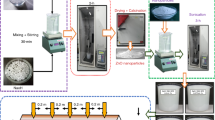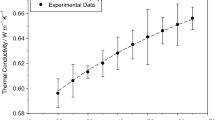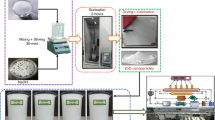Abstract
The thermophysical properties of freely suspended ZnO and TiO2 nanoparticles in a base fluid (DW) with different mass% concentrations of ZnO@TiO2/DW binary composite nanofluids (0.1, 0.075, 0.05 and 0.025 mass%) are deliberated. ZnO have been synthesized by using a facile single-pot sonochemical method and mixed with TiO2 under high probe sonication to prepare binary composite nanofluid. The experiment of effective thermal conductivity was executed in the temperature range of 20–45 °C. The positive improvement in thermal conductivity value for ZnO@TiO2/DW binary composite nanofluids was recorded for 0.1 mass%, and the highest improvement was measured up to 36%, greater than the base fluids (DW). The convective heat transfer properties of the ZnO@TiO2/DW binary composite nanofluids with different concentrations and base fluid (DW) were also examined by using complete experimental test rig with a circular heat exchanger based on a constant heat flux boundary conditions. All the concentrations were examined to check the local and average improvement in heat transfer with Reynolds range from 5849 to 24,544. The increase in nanoparticles mass% in base fluid causes to raise the heat transfer coefficient (h) which is due to the composite nanoparticles. Finally, the maximum 600–1950 W m−2 K−1 enhancement was found in convective heat transfer with an increase in 0.1 mass% of composite nanoparticles, which is 69% greater than base fluid, while all other concentrations also shows positive enhancement as compared to base fluid (600–1870, 600–1700 and 600–1500) W m−2 K−1 correspondingly.
Graphic abstract
















Similar content being viewed by others
Abbreviations
- Nu:
-
Nusselt numbers
- D h :
-
Pipe diameter
- C Pnf :
-
Heat capacity for nanofluid
- P P :
-
Pumping power
- Q :
-
Heat flux
- f f :
-
Friction factor
- mass%:
-
Particle mass concentration
- k :
-
Thermal conductivity (W m−1 K−1)
- I :
-
Inlet condition
- PN:
-
Prandtl numbers, Pr = cp·η/k
- S gen :
-
Entropy ratio
- B :
-
Bulk value
- c p :
-
Specific heat (J kg−1 K−1)
- Re:
-
Reynolds numbers, Re = ρ·v·D/η
- FESEM:
-
Field emission scanning electron microscopy
- R :
-
Ration of nanoparticles
- DW:
-
Distilled water
- A :
-
Area of pipe
- L :
-
Total length of the test pipe
- T out :
-
Outlet temperature
- T in :
-
Inlet temperature
- T s :
-
Pipe surface temperature
- T b :
-
Fluid bulk temperature
- V :
-
Velocity (m s−1)
- TC:
-
Thermocouple
- µ :
-
Dynamical viscosity (MPa s)
- ρ :
-
Fluid density in (kg m−3)
- ω :
-
Mass concentration (%)
- η :
-
Efficiency
- nf:
-
Nanofluid
- bf:
-
Value of base fluid
- Np:
-
Nanoparticle
- Cnf:
-
Composite nanofluid
- hnf:
-
Hybrid nanofluids
References
Sadri R, Mallah AR, Hosseini M, Ahmadi G, Kazi SN, Dabbagh A. CFD modeling of turbulent convection heat transfer of nanofluids containing green functionalized graphene nanoplatelets flowing in a horizontal tube: comparison with experimental data. J Mol Liq. 2018;269:152–9.
Amani M, Amani P, Kasaeian A, Mahian O, Wongwises S. Thermal conductivity measurement of spinel-type ferrite MnFe2O4 nanofluids in the presence of a uniform magnetic field. J Mol Liq. 2017;230:121–8.
Chaurasia P, Kumar A, Yadav A, Rai PK, Kumar V, Prasad L. Heat transfer augmentation in automobile radiator using Al2O3–water based nanofluid. SN Appl Sci. 2019;1(3):257.
Sedeh RN, Abdollahi A, Karimipour A. Experimental investigation toward obtaining nanoparticles’ surficial interaction with basefluid components based on measuring thermal conductivity of nanofluids. Int Commun Heat Mass Transf. 2019;103:72–82.
Esmaeili E, Rounaghi SA, Gruner W, Eckert J. The preparation of surfactant-free highly dispersed ethylene glycol-based aluminum nitride–carbon nanofluids for heat transfer application. Adv Powder Technol. 2019;30:2032–41.
Poongavanam GK, Kumar B, Duraisamy S, Panchabikesan K, Ramalingam V. Heat transfer and pressure drop performance of solar glycol/activated carbon based nanofluids in shot peened double pipe heat exchanger. Renew Energy. 2019;140:580–91.
Esfe MH, Rostamian H, Sarlak MR. A novel study on rheological behavior of ZnO–MWCNT/10w40 nanofluid for automotive engines. J Mol Liq. 2018;254:406–13.
Goodarzi M, Toghraie D, Reiszadeh M, Afrand M. Experimental evaluation of dynamic viscosity of ZnO–MWCNTs/engine oil hybrid nanolubricant based on changes in temperature and concentration. J Therm Anal Calorim. 2019;136(2):513–25.
Soylu SK, Atmaca İ, Asiltürk M, Doğan A. Improving heat transfer performance of an automobile radiator using Cu and Ag doped TiO2 based nanofluids. Appl Therm Eng. 2019;157:113743.
Motevasel M, Nazar ARS, Jamialahmadi M. Experimental study on turbulent convective heat transfer of water-based nanofluids containing alumina, copper oxides and silicon carbide nanoparticles. J Therm Anal Calorim. 2019;135(1):133–43.
Selvakumar RD, Dhinakaran S. Nanofluid flow and heat transfer around a circular cylinder: a study on effects of uncertainties in effective properties. J Mol Liq. 2016;223:572–88.
Sadri R, Ahmadi G, Togun H, Dahari M, Kazi SN, Sadeghinezhad E. An experimental study on thermal conductivity and viscosity of nanofluids containing carbon nanotubes. Nanoscale Res Lett. 2014;9(1):151.
Poongavanam GK, Ramalingam V. Characteristics investigation on thermophysical properties of synthesized activated carbon nanoparticles dispersed in solar glycol. Int J Therm Sci. 2019;136:15–32.
Wang D, Saleh NB, Sun W, Park CM, Shen C, Aich N. Next-generation multifunctional carbon–metal nanohybrids for energy and environmental applications. Environ Sci Technol. 2019;53:7265–87.
Schroeder V, Savagatrup S, He M, Lin S, Swager T. Carbon nanotube chemical sensors. Nano Lett. 2018;119(1):599–663.
Fan J, Wang L. Review of heat conduction in nanofluids. J Heat Transf. 2011;133(4):040801.
Yang Y, Zhang ZG, Grulke EA, Anderson WB, Wu G. Heat transfer properties of nanoparticle-in-fluid dispersions (nanofluids) in laminar flow. Int J Heat Mass Transf. 2005;48(6):1107–16.
Nanda J, Maranville C, Bollin SC, Sawall D, Ohtani H, Remillard JT. Thermal conductivity of single-wall carbon nanotube dispersions: role of interfacial effects. J Phys Chem C. 2008;112(3):654–8.
Choi S, Zhang Z, Yu W, Lockwood F, Grulke E. Anomalous thermal conductivity enhancement in nanotube suspensions. Appl Phys Lett. 2001;79(14):2252–4.
Liu M-S, Lin MC-C, Huang I-T, Wang C-C. Enhancement of thermal conductivity with carbon nanotube for nanofluids. Int Commun Heat Mass Transf. 2005;32(9):1202–10.
Garg P, Alvarado JL, Marsh C, Carlson TA, Kessler DA, Annamalai K. An experimental study on the effect of ultrasonication on viscosity and heat transfer performance of multi-wall carbon nanotube-based aqueous nanofluids. Int J Heat Mass Transf. 2009;52(21–22):5090–101.
Yu W, Xie H, Li Y, Chen L, Wang QJC, Physicochemical SA. Experimental investigation on the thermal transport properties of ethylene glycol based nanofluids containing low volume concentration diamond nanoparticles. Powder Technol. 2011;380(1–3):1–5.
Baby TT, Ramaprabhu S. Investigation of thermal and electrical conductivity of graphene based nanofluids. J Appl Phys. 2010;108(12):124308.
Hu Z, Srinivasan MJM, Materials M. Preparation of high-surface-area activated carbons from coconut shell. Microporous Mesoporous Mater. 1999;27(1):11–8.
Kadirvelu K, Palanival M, Kalpana R, Rajeswari SJBT. Activated carbon from an agricultural by-product, for the treatment of dyeing industry wastewater. Biresour Technol. 2000;74(3):263–5.
Bhattacharyya KG, Sharma A. Adsorption of Pb(II) from aqueous solution by Azadirachta indica (Neem) leaf powder. J Hazard Mater. 2004;113(1–3):97–109.
Adinata D, Daud WMAW, Aroua MK. Preparation and characterization of activated carbon from palm shell by chemical activation with K2CO3. Biresour Technol. 2007;98(1):145–9.
Hameed B, Daud F. Adsorption studies of basic dye on activated carbon derived from agricultural waste: Hevea brasiliensis seed coat. Chem Eng J. 2008;139(1):48–55.
Bharadwaj D, Lundquist P, Alstrom SJAJES. Carbon nanomaterial from tea leaves as an anode in lithium secondary batteries. Asian J Exp Sci. 2008;22:89–93.
Musa SD, Zhonghua T, Ibrahim AO, Habib MJR, Reviews SE. China’s energy status: a critical look at fossils and renewable options. Renew Sustain Energy Rev. 2018;81:2281–90.
Li D, Fang W, Zhang Y, Wang X, Guo M, Qin XJI. Stability and thermal conductivity enhancement of silver nanofluids with gemini surfactants. Ind Eng Chem Res. 2017;56(43):12369–75.
Mahrukh M, Kumar A, Gu S, Kamnis S, Gozali E. Modeling the effects of concentration of solid nanoparticles in liquid feedstock injection on high-velocity suspension flame spray process. Ind Eng Chem Res. 2016;55(9):2556–73.
Singh G, Lopes E, Hentges N, Becker D, Ratner A. Experimental investigation of the settling characteristics of carbon and metal oxide nanofuels. arXiv preprint http://arxiv.org/abs/1911.12238.
Kumar N, Sonawane SS, eds. Convective heat transfer of metal oxide-based nanofluids in a shell and tube heat exchanger. In: Conference proceedings of the second international conference on recent advances in bioenergy research. Berlin: Springer; 2018.
Branson BT, Beauchamp PS, Beam JC, Lukehart CM, Davidson JLJAN. Nanodiamond nanofluids for enhanced thermal conductivity. ACS Nano. 2013;7(4):3183–9.
Shima PD, Philip J. Role of thermal conductivity of dispersed nanoparticles on heat transfer properties of nanofluid. Ind Eng Chem Res. 2014;53(2):980–8.
Angayarkanni S, Philip J. Role of adsorbing moieties on thermal conductivity and associated properties of nanofluids. J Phys Chem C. 2013;117(17):9009–19.
Moosavi M, Goharshadi EK, Youssefi A. Fabrication, characterization, and measurement of some physicochemical properties of ZnO nanofluids. Int J Heat Fluid Flow. 2010;31(4):599–605.
Gao J, Zheng R, Ohtani H, Zhu D, Chen G. Experimental investigation of heat conduction mechanisms in nanofluids. Clue on clustering. Nano Lett. 2009;9(12):4128–32.
Singh V, Gupta M, Kumar A, eds. Investigating the morphology and thermophysical properties of Al2O3 and CuO nanofluids. IOP conference series: materials science and engineering. IOP Publishing; 2019.
Chaudhari S, Chakule R, Talmale P. Experimental study of heat transfer characteristics of Al2O3 and CuO nanofluids for machining application. Mater Today Proc. 2019;18:788–97.
Rahbar K, Riasi A, Sangjoeei HKB, Razmjoo N. Heat recovery of nano-fluid based concentrating photovoltaic thermal (CPV/T) collector with organic rankine cycle. Energy Convers Manag. 2019;179:373–96.
Asadi A, Asadi M, Rezaniakolaei A, Rosendahl LA, Afrand M, Wongwises S. Heat transfer efficiency of Al2O3–MWCNT/thermal oil hybrid nanofluid as a cooling fluid in thermal and energy management applications: an experimental and theoretical investigation. Int J Heat Mass Transf. 2018;117:474–86.
Parsian A, Akbari M. New experimental correlation for the thermal conductivity of ethylene glycol containing Al2O3–Cu hybrid nanoparticles. Therm Anal Calorim. 2018;131(2):1605–13.
Safi M, Ghozatloo A, Shariaty NM, Hamidi A. Preparation of MWNT/TiO2 nanofluids and study of its thermal conductivity and stability; 2014.
Nine M, Batmunkh M, Kim J, Chung H, Jeong H. Investigation of Al2O3–MWCNTs hybrid dispersion in water and their thermal characterization. J Nanosci Nanotechnol. 2012;12:4553–9.
Tahat MS, Benim AC, eds. Experimental analysis on thermophysical properties of Al2O3/CuO hybrid nano fluid with its effects on flat plate solar collector. Defect and diffusion forum. Trans Tech Publ; 2017.
Suresh S, Venkitaraj K, Selvakumar P, Chandrasekar M. Synthesis of Al2O3–Cu/water hybrid nanofluids using two step method and its thermo physical properties. Colloids Surf A Physicochem Eng Asp. 2011;388(1–3):41–8.
Esfe MH, Arani AAA, Rezaie M, Yan W-M, Karimipour A. Experimental determination of thermal conductivity and dynamic viscosity of Ag–MgO/water hybrid nanofluid. Int Commun Heat Mass Transf. 2015;66:189–95.
Yarmand H, Gharehkhani S, Ahmadi G, Shirazi SFS, Baradaran S, Montazer E. Graphene nanoplatelets–silver hybrid nanofluids for enhanced heat transfer. Energy Convers Manag. 2015;100:419–28.
Paul G, Philip J, Raj B, Das PK, Manna I. Synthesis, characterization, and thermal property measurement of nano-Al95Zn05 dispersed nanofluid prepared by a two-step process. Int J Heat Mass Transf. 2011;54(15–16):3783–8.
Abdolbaqi MK, Sidik NAC, Aziz A, Mamat R, Azmi W, Yazid M. An experimental determination of thermal conductivity and viscosity of BioGlycol/water based TiO2 nanofluids. Int Commun Heat Mass Transf. 2016;77:22–32.
Yu W, Xie H. A review on nanofluids: preparation, stability mechanisms, and applications. J Nanomater. 2012;2012:1.
Ghadimi A, Saidur R, Metselaar H. A review of nanofluid stability properties and characterization in stationary conditions. Int J Heat Mass Transf. 2011;54(17–18):4051–68.
Fernandez-Seara J, Uhía FJ, Sieres J, Campo AJATE. A general review of the Wilson plot method and its modifications to determine convection coefficients in heat exchange devices. Appl Therm Eng. 2007;27(17–18):2745–57.
Holman JP, Gajda WJ. Experimental methods for engineers. New York: McGraw-Hill; 2001.
Xu S, Fu L, Pham TSH, Yu A, Han F, Chen L. Preparation of ZnO flower/reduced graphene oxide composite with enhanced photocatalytic performance under sunlight. Ceram Int. 2015;41(3):4007–13.
Jwo C-S, Jeng L-Y, Chang H, Teng T-P. Experimental study on thermal conductivity of lubricant containing nanoparticles. Rev Adv Mater Sci. 2008;18:660–6.
Habibzadeh S, Kazemi-Beydokhti A, Khodadadi AA, Mortazavi Y, Omanovic S, Shariat-Niassar M. Stability and thermal conductivity of nanofluids of tin dioxide synthesized via microwave-induced combustion route. Chem Eng J. 2010;156(2):471–8.
Lee K, Hwang Y, Cheong S, Kwon L, Kim S, Lee JJCAP. Performance evaluation of nano-lubricants of fullerene nanoparticles in refrigeration mineral oil. Curr Appl Phys. 2009;9(2):e128–31.
Yarmand H, Gharehkhani S, Shirazi SFS, Goodarzi M, Amiri A, Sarsam WS, et al. Study of synthesis, stability and thermo-physical properties of graphene nanoplatelet/platinum hybrid nanofluid. Int Commun Heat Mass Transf. 2016;77:15–21.
Ghosh M, Ghosh S, Pabi S. Effects of particle shape and fluid temperature on heat-transfer characteristics of nanofluids. J Mater Eng Perform. 2013;22(6):1525–9.
Harandi SS, Karimipour A, Afrand M, Akbari M, D’Orazio A. An experimental study on thermal conductivity of F-MWCNTs–Fe3O4/EG hybrid nanofluid: effects of temperature and concentration. Int Commun Heat Mass Transf. 2016;76:171–7.
Kumar MS, Vasu V, Gopal AV. Thermal conductivity and rheological studies for Cu–Zn hybrid nanofluids with various basefluids. J Taiwan Inst Chem Eng. 2016;66:321–7.
Ahammed N, Asirvatham LG, Wongwises S. Entropy generation analysis of graphene–alumina hybrid nanofluid in multiport minichannel heat exchanger coupled with thermoelectric cooler. Int J Heat Mass Transf. 2016;103:1084–97.
Esfe MH, Wongwises S, Naderi A, Asadi A, Safaei MR, Rostamian H. Thermal conductivity of Cu/TiO2–water/EG hybrid nanofluid: experimental data and modeling using artificial neural network and correlation. Int Commun Heat Mass Transf. 2015;66:100–4.
Duangthongsuk W, Wongwises S. Effect of thermophysical properties models on the predicting of the convective heat transfer coefficient for low concentration nanofluid. Int Commun Heat Mass Transf. 2008;35(10):1320–6.
Gnielinski V. New equations for heat and mass transfer in the turbulent flow in pipes and channels. NASA STI/Recon Tech Rep A. 1975;75:8–16.
Petukhov B. Heat transfer and friction in turbulent pipe flow with variable physical properties. Adv Heat Transf. 1970;6:503–64.
Acknowledgements
The authors gratefully acknowledge the UMRG Grant RP045C-17AET, UM Research University Grant GPF050A-2018, Institute of Advanced Studies, Nanotechnology and Catalysis Research Center, Department of Mechanical Engineering and the University of Malaya for the support to conduct this research work.
Author information
Authors and Affiliations
Corresponding authors
Ethics declarations
Conflict of interest
The authors declare that they have no competing interests.
Additional information
Publisher's Note
Springer Nature remains neutral with regard to jurisdictional claims in published maps and institutional affiliations.
Rights and permissions
About this article
Cite this article
Ahmed, W., Kazi, S.N., Chowdhury, Z.Z. et al. Experimental investigation of convective heat transfer growth on ZnO@TiO2/DW binary composites/hybrid nanofluids in a circular heat exchanger. J Therm Anal Calorim 143, 879–898 (2021). https://doi.org/10.1007/s10973-020-09363-x
Received:
Accepted:
Published:
Issue Date:
DOI: https://doi.org/10.1007/s10973-020-09363-x




